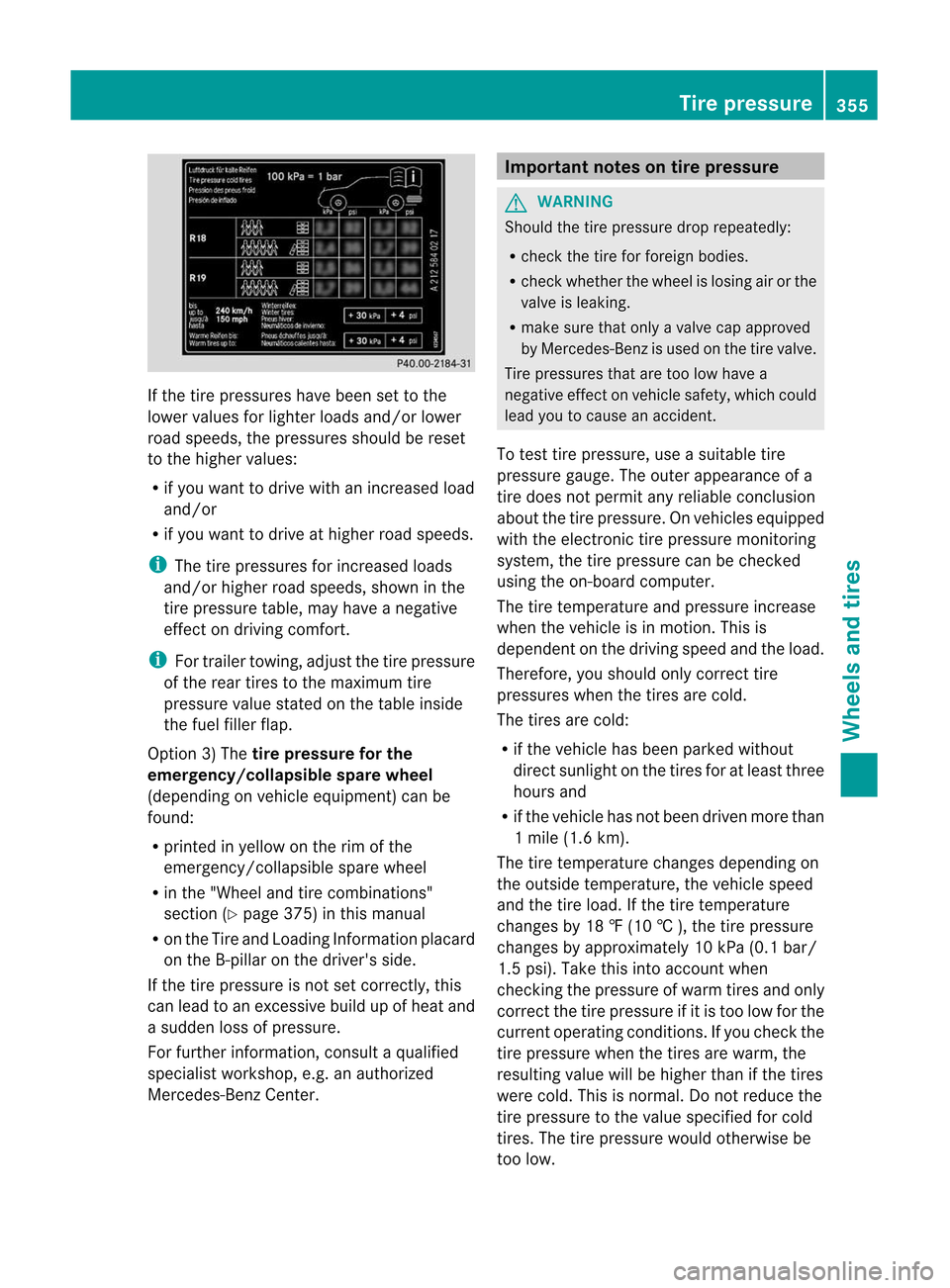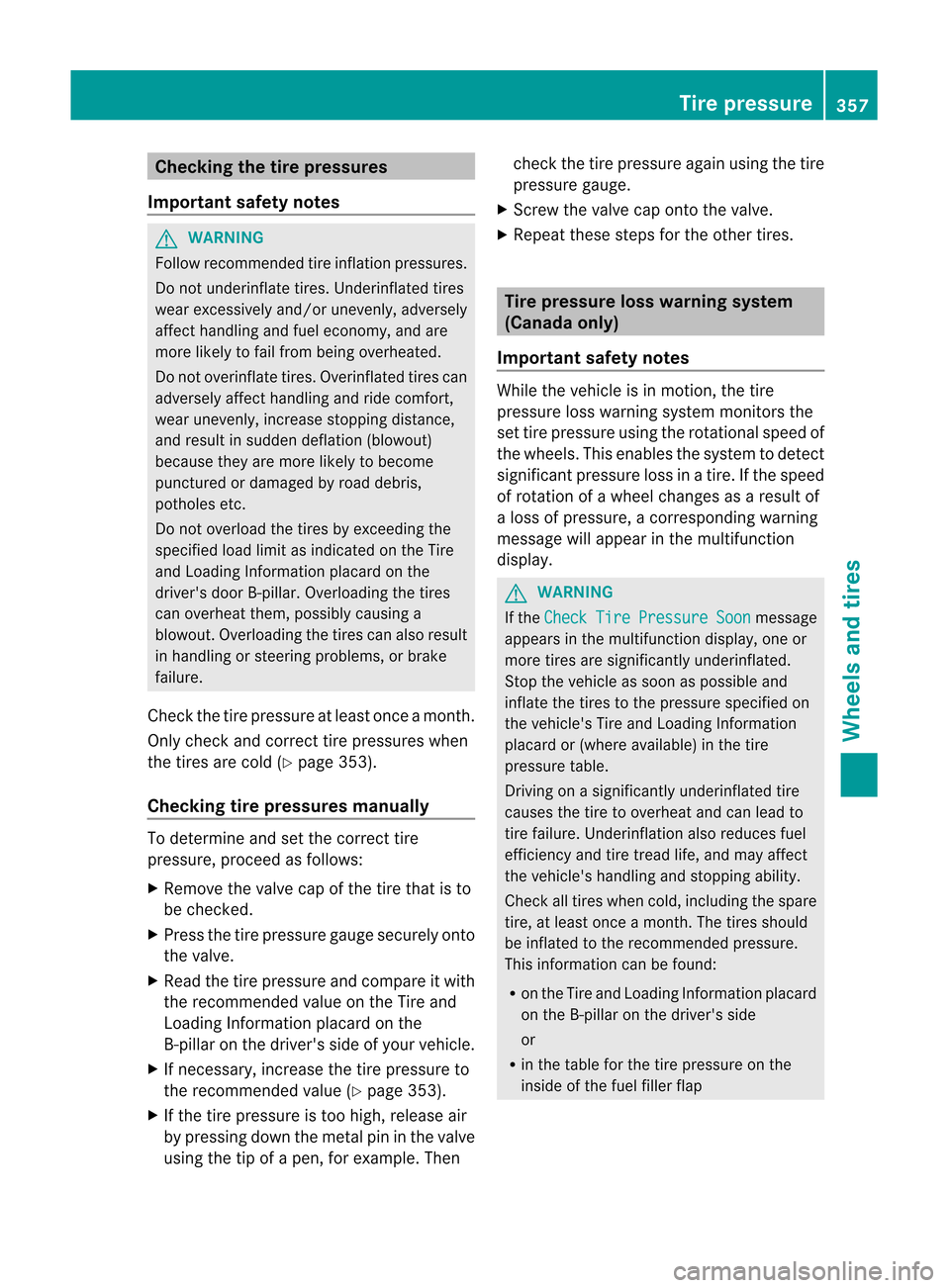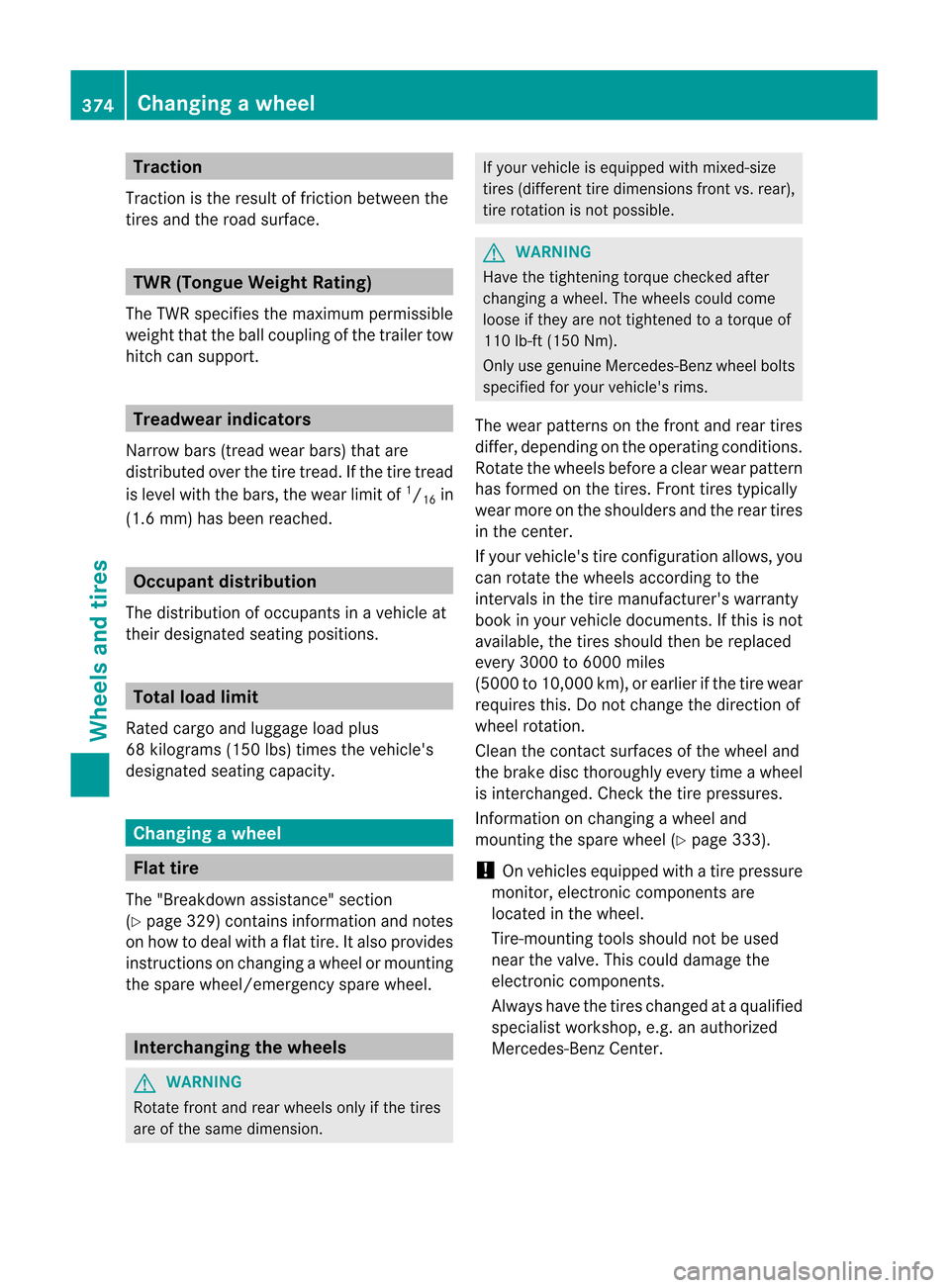change wheel MERCEDES-BENZ M-Class 2012 W166 Owner's Guide
[x] Cancel search | Manufacturer: MERCEDES-BENZ, Model Year: 2012, Model line: M-Class, Model: MERCEDES-BENZ M-Class 2012 W166Pages: 396, PDF Size: 14.48 MB
Page 357 of 396

If
the tire pressu reshave been settothe
lowe rvalues forlight erloads and/or lower
road speeds,thepres suressho uld beres et
to thehigh ervalues :
R ifyou want todriv ewit han increas edload
and /or
R ifyou want todriv eat high erroad speeds. i
The
tirepres suresfor increas edloads
and /or high erroad speeds,sho wninthe
tir epres sure table,may have ane gat ive
eff ect ondriv ingcomf ort . i
For
trailer towing ,adj ust thetir epres sure
of therear tires tothemax imum tire
pres sure value state don thet able inside
th efuel fillerflap.
Opt ion 3)The tirepr essur efor the
emer gency/collap siblesparewheel
(depen dingonvehic leequipmen t)can be
foun d:
R prin tedinyellow onthe rim ofthe
emer gency/c ollapsible sparewheel
R in the "Wheel andtirecom binat ions"
sect ion(Ypage 375)in this manual
R on the Tire andLoadin gIn for mat ionplacard
on the B-pillar onthe drive r'sside.
If the tirepress ureisnot setcorrectly, this
can lead toan exc essiv ebuild upofheat and
a sudde nloss ofpressure.
For further information,consult aquali fied
specialist workshop, e.g.anauthorized
Mercedes-B enzCenter. Import
antnotes ontire pressur e G
WARNIN
G Should
thetire pressure droprepeatedly:
R check thetire forforeign bodies.
R check whether thewheel islosing airorthe
valve isleaking.
R make surethatonly avalve capapproved
by Mercedes-B enzisused onthe tire valve.
Tire pressures thataretoo low have a
negative effectonvehicle safety,whichcould
lead youtocause anaccident .
To test tirepressure, useasuitable tire
pressure gauge.Theouter appearance ofa
tire does notpermit anyreliable conclusion
about thetire pressure. Onvehicles equipped
with theelectron ictire pressure monitoring
system, thetire pressure canbecheck ed
using theon-board computer.
The tiretemperat ureand pressure increase
when thevehicle isin motion .This is
dependent onthe driving speedandtheload.
Therefore, youshould onlycorrect tire
pressures whenthetires arecold.
The tires arecold:
R ifthe vehicle hasbeen parked without
direct sunlight onthe tires foratleast three
hours and
R ifthe vehicle hasnotbeen driven morethan
1 mile (1.6km).
The tiretemperature changesdepending on
the outside temperature, thevehicle speed
and thetire load. Ifthe tire temperature
changes by18 ‡(10 †),the tire pressure
changes byapproximately 10kPa (0.1 bar/
1.5 psi). Take thisinto account when
check ingthe pressure ofwarm tiresandonly
correct thetire pressure ifit is too low forthe
current operating conditions.Ifyou check the
tire pressure whenthetires arewarm, the
resulting valuewillbehigher thanifthe tires
were cold.Thisisnormal. Donot reduce the
tire pressure tothe value specified forcold
tires. Thetirepressure wouldotherwise be
too low. Tire
pressure
355Wheels and tires Z
Page 359 of 396

Check
ingthetir epr essu res
Imp ortant safety notes G
WAR
NING Fol
low recomm ended tireinf lati onpres sures.
Do notunde rinflat etir es. Underi nflate dtir es
wear exces sively and /or unevenly,adve rsely
aff ect handlingand fuel economy, and are
mor elik ely tofail from bein gove rheated.
Do notoverinfla tetires. Overinfla tedtires can
adve rsely affect handlingand ride comfort,
wea runeve nly,incre asestop ping dista nce,
and resulti ns udden deflation (blowo ut)
bec ause they are mor elik ely tobec ome
pun ctured ordamag edbyroad debris,
pot hole set c.
Do noto verloa dthe tires byexceedi ngthe
specifi edloadlimi tasindicated onthe Tire
and Loading Information placardonthe
driver's doorB-pillar. Overloading thetires
can overheat them,possibly causinga
blowou t.Overloading thetires canalso result
in handling orsteering problems, orbrake
failu re.
Check thetire pressure atleast once amonth.
Only check andcorrect tirepressures when
the tires arecold (Ypage 353).
Checki ngtire pressures manually To
determine andsetthe correct tire
pressure, proceedasfollows:
X Remove thevalve capofthe tire that isto
be checked.
X Press thetire pressure gaugesecurely onto
the valve.
X Read thetire pressure andcompare itwith
the recommended valueonthe Tire and
Loading Information placardonthe
B-pillar onthe driver's sideofyour vehicle.
X Ifnecessary, increasethetire pressure to
the recommended value(Ypage 353).
X Ifthe tire pressure istoo high, release air
by pressing downthemetal pininthe valve
using thetipofapen, forexample. Then check
thetire pressure againusing thetire
pressure gauge.
X Screw thevalve caponto thevalve.
X Repea tthese steps forthe other tires. Tire
pressur eloss warning system
(Canada only)
Import antsafety notes While
thevehicle isin motion, thetire
pressure losswarning systemmonitors the
set tire pressure usingtherotational speedof
the wheels. Thisenables thesystem todetect
significant pressurelossinatire. Ifthe speed
of rotation ofawheel changes asaresult of
a loss ofpressure, acorresponding warning
message willappea rint he multifunction
displa y. G
WARNING If
the Check Tire Pressure Soon message
appears inthe multifunction display,one or
more tiresaresignificantly underinflated.
Stop thevehicle assoon aspossible and
inflate thetires tothe pressure specified on
the vehicle's TireandLoading Information
placard or(where available)inthe tire
pressure table.
Driving onasignificantly underinflated tire
causes thetire tooverheat andcanlead to
tire failure. Underinflation alsoreduces fuel
efficiency andtiretread life,and may affect
the vehicle's handlingandstopping ability.
Check alltires when cold,including thespare
tire, atleast once amont h.The tires should
be inflated tothe recommen dedpressure.
This information canbefound:
R on the Tire andLoading Informationplacard
on the B-pillar onthe driver's side
or
R in the table forthe tire pressure onthe
inside ofthe fuel filler flap Tire
pressure
357Wheels and tires Z
Page 376 of 396

Trac
tion
Tra ctio nis the resultof frictio nbe twe enthe
tire sand theroadsu rfa ce. TWR
(Tongue We ight Ratin g)
The TWRsp eci fiesthe maxim um permi ssible
we ight tha tthe ball coupling ofthe trailer tow
hitch cansupport. Tread
wearindicators
Narrow bars(tread wearbars) thatare
distributed overthetire tread. Ifthe tire tread
is level withthebars, thewear limitof1
/ 16 in
(1.6 mm) hasbeen reached. Occupant
distribution
The distribution ofoccupants inavehicle at
their designated seatingpositions. Total
loadlimit
Rated cargoandlugga geload plus
68 kilograms (150lbs)times thevehicle's
designated seatingcapacity. Changing
awhee l Fl
at tire
The "Brea kdown assistance" section
(Y pag e329) contains informationandnotes
on how todea lwith afla ttire. Italso provides
inst ruct ions onchan gingawheel ormoun ting
the spare wheel/ emergencyspare wheel. Inter
chang ingthewheels G
WARN
ING Rotat
efro ntand rear wheels onlyifthe tires
are ofthe same dimen sion. If
your vehic leisequipped withmixed-s ize
tir es (diff eren ttire dimen sionsfro ntvs. rear),
tir erot ation isnot possible . G
WARN
ING Have
thetightening torque chec kedafter
chan gingawheel. Thewheels couldcome
loose ifthe yare not tightenedtoator que of
110 lb-ft(150 Nm).
Only usegenuin eMerc edes- Benzwheel bolts
specified foryour vehicle's rims.
The wear pattern son the front andrear tires
differ, depending onthe operating conditions.
Rotate thewheels beforeaclear wearpattern
has formed onthe tires. Front tirestypically
wear more onthe shoulders andtherear tires
in the cent er.
If your vehicle's tireconfiguration allows,you
can rotate thewheels according tothe
intervals inthe tire manufacturer's warranty
book inyour vehicle documents. Ifthis isnot
availa ble,thetires should thenbereplaced
every 3000to6000 miles
(5000 to10,000 km),orearl ierifthe tire wea r
requ iresthis. Donot change thedirection of
whee lrotation.
Cle anthe contact surfacesofthe whee land
the brake discthoroug hlyevery timeawhee l
is interchanged .Check thetire pressures.
Inform ationonchanging awheel and
mounting thespare wheel (Ypage 333).
! Onvehicles equippedwith atire pressure
monitor, electronic componentsare
located inthe wheel.
Tire-mountin gtools should notbeused
near thevalve. Thiscould damage the
electronic components.
Always havethetires changed ataqual ified
specialist workshop, e.g.anauthorized
Mercedes-Ben zCent er. 374
Changing
awhee lWheels and tires